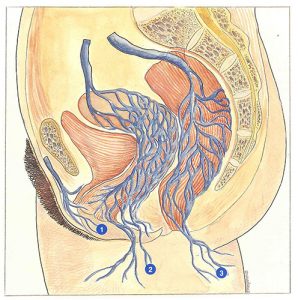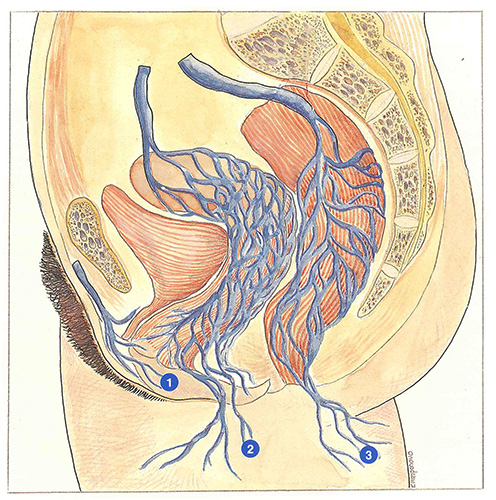Vulval varices
Vulval varices, reported in 5% to 10% of pregnancies, may appear suddenly by the second month of pregnancy. They tend to occur more frequently from the second pregnancy onwards and are generally asymptomatic. However, they may be accompanied by vulval heaviness, pruritus or burning.
These varices may be supplied in three different ways:
- an incompetent long saphenous arch, via a superficial external pudendal branch;
- the internal iliac vein, via internal pudendal veins or uterine and vaginal veins;
- left or right ovarian veins.
Vulval varices supplied by ovarian veins have been studied in particular detail by selective phlebography. The right ovarian vein drains directly into the inferior vena cava several centimetres below the anastomosis of the right renal vein. The left ovarian vein drains into the ipsilateral renal vein, which lies between the aorta and the superior mesenteric artery, before joining the inferior vena cava. This particular configuration explains why, in the standing position, due to the weight of the small intestine, the superior mesenteric artery compresses the left renal vein, resulting in stasis or even the development of a countercurrent circulation in the left ovarian vein. This phenomenon is further accentuated during pregnancy. Drainage via the right ovarian vein develops in order to compensate for the interference to drainage of uterine venous blood by the left ovarian vein. The overload on the right ovarian vein is reflected by filling of the vulval varices.

Further reading
Varices périnéales
Bergan J.J., Yao J. Venous disorders, W.B. Saunders Company, 1991.
Varices vulvaires
Dixon J.A., Mitchell W.A. Venographic and surgical observations in vulval varicose veins. Surg Gynecol Obst, 1970, 131
458-64.
Lechter A., Alvarey A., Lopez G. Pelvic varices and gonadal
veins. Phlebolo , 1989, 2: 181-8.
Varices fessières
Lefebvre D., Bastide G., Vaysse Ph., Roux R., Joly R. Connexions veineuses intra et extrapelviennes. Étude anatomique. Phlébologie, 1989, 42: 385-9.
Van Der Stricht J., Van Oppens C. Where do vulvar varices come from ? Phlébologie 89, J. Libbey Eurotext, 1989 473-5.
